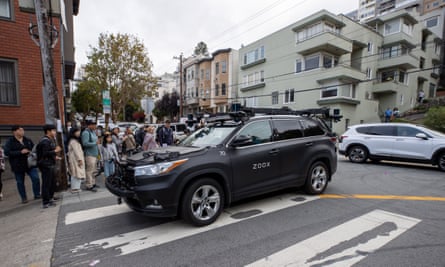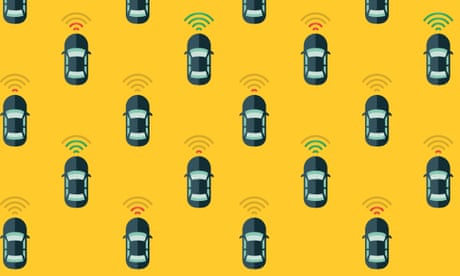Online retailer has been aggressively expanding into driverless technology and bought the startup Zoox
Amazon tests a fleet of driverless 'robotaxis' in California – video
Guardian staff and agencies
Tue 14 Feb 2023
Amazon is testing a fleet of robotaxis on public roads in California, using employees as passengers, as the tech behemoth moves closer to a commercial service for the general public.
The online retailer has been aggressively expanding into self-driving technology and bought the self-driving startup Zoox for $1.3bn in 2020. A test conducted on 11 February saw the robotaxis successfully drive between two Zoox buildings a mile apart at its headquarters in Foster City, California. It was part of the launch of a no-cost employee shuttle service that will also help the company refine its technology.
Zoox’s robotaxi – built as a fully autonomous vehicle from scratch rather than retrofitting existing cars for self-driving – comes without a steering wheel or pedals and has room for four passengers, with two facing each other.
Amazon is testing a fleet of robotaxis on public roads in California, using employees as passengers, as the tech behemoth moves closer to a commercial service for the general public.
The online retailer has been aggressively expanding into self-driving technology and bought the self-driving startup Zoox for $1.3bn in 2020. A test conducted on 11 February saw the robotaxis successfully drive between two Zoox buildings a mile apart at its headquarters in Foster City, California. It was part of the launch of a no-cost employee shuttle service that will also help the company refine its technology.
Zoox’s robotaxi – built as a fully autonomous vehicle from scratch rather than retrofitting existing cars for self-driving – comes without a steering wheel or pedals and has room for four passengers, with two facing each other.
 An autonomous Zoox car during a test drive through Lombard Street in San Francisco, California, in October. Photograph: Anadolu Agency/Getty Images
An autonomous Zoox car during a test drive through Lombard Street in San Francisco, California, in October. Photograph: Anadolu Agency/Getty Images“Putting the vehicle on [an] open public road and validating our approach to all of the different requirements, including regulatory, is a big step and we would not have done it unless internally we were already looking at the line of sight for going commercial,” chief executive Aicha Evans told reporters on a conference call.

How self-driving cars got stuck in the slow lane
Evans declined to provide a timeline for the commercial launch, which will need additional government clearances.
Despite Silicon Valley’s promise to revolutionize the way we drive, autonomous vehicles have been slower to roll out than expected, and the technology has proven tough to master. Ford and Volkswagen last fall announced they would shutter their Argo AI self-driving unit and focus on driver-assistance technology that provided more immediate returns.
Companies still pursuing development of this technology include General Motors’ Cruise unit and Alphabet’s Waymo.
But rapid interest rate hikes and weak consumer demand sparked fears of a global recession, forcing many companies, including automakers and tech giants, to trim their workforces and claw back costs.
Zoox’s tech chief, Jesse Levinson, said the company has been prudent about its growth but was still on track to reach 2,500 employees this year, up from just under 2,000 employees at the beginning of the year.
Reuters contributed reporting
No comments:
Post a Comment